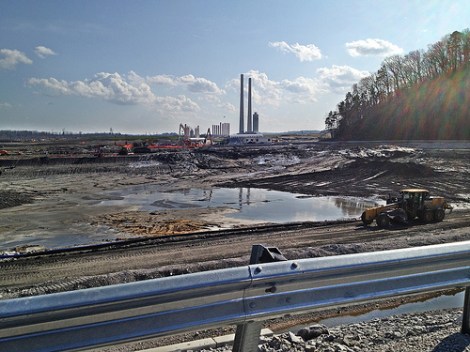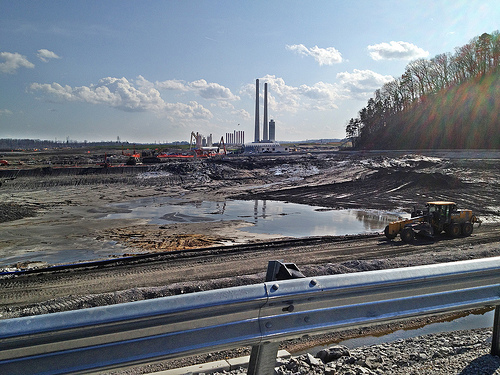Coal ash is exactly what it sounds like: the residue of burned coal. It might sound innocuous, like what you might find in a used fireplace.
It isn’t. In its a proposed regulation for coal ash released in 2010, the EPA outlined its concerns:
The constituents of concern associated with [coal ash] include antimony, arsenic, barium, beryllium, cadmium, hexavalent chromium, lead, mercury, nickel, selenium, silver, and thallium. … [T]he Agency believes that the metals identified are sufficiently toxic that they are capable of posing a substantial present or potential hazard to human health and the environment when improperly treated, stored, transported disposed of, or otherwise managed.
That 2010 proposed regulation has not been implemented. And, unsurprisingly, there’s no chance that it will be implemented within the next few weeks. After all, we’re on the cusp of Election Day.

Appalachian VoicesOngoing cleanup from the Tennessee Valley Authority’s 2008 coal-ash spill.
From the Washington Post:
President Obama and challenger Mitt Romney both stress that they support coal operations, and Republicans and Democrats agree that the federal government needs to establish a national standard for managing coal ash, also known as fly ash.
Water contaminated by coal ash violated federal drinking water or health standards at at least 197 sites in 37 states, including seven in Virginia and three in Maryland, according to the environmental group Earthjustice. The EPA gave 45 ponds at 27 locations in the United States a “high hazard potential rating,” meaning that if the encasing for the ponds break, it would probably result in the loss of human life.
But should coal ash be labeled a hazardous waste? That determination will give the EPA direct enforcement authority over coal ash, rather than leaving it to the states, and will impose new handling procedures on utilities that will increase their costs. And while EPA and environmentalists say this will heighten the incentive for recycling, given the higher cost of disposal, recycling companies and mining industry officials predict fewer companies will be willing to incorporate coal ash into their products if it’s labeled as hazardous.
For those who live near coal-ash dumping sites, there’s little question about the hazard. One family, the Havens, is selling its West Virginia home to escape seepage from a nearby coal-ash pond and the heavy smell of hydrogen sulfide in the air. In one sense, they’re lucky.
The Moapa Band of Paiutes members are far less able to move.
“This is our birthplace,” said William Anderson, the tribe’s chairman. “This is our home.” The reservation is adjacent to the Reid Gardner Generating Station. Clouds of coal ash sometimes blow over from a landfill next to the plant; residents question why 10 of 15 children living closest to the station have asthma, and the groundwater has had 136 known drinking water violations since 2010.
The latest assessment of how coal ash affects the environment around coal-burning power plants, released today, suggests that coal ash may pose a larger threat to water supplies than air quality.
Researchers at Duke University in Durham, N.C. analyzed more than 300 water samples from 11 water bodies across the state, finding several cases where levels of contamination far exceeded U.S. Environmental Protection Agency (EPA) standards for safe drinking water and aquatic life. …
The study’s findings suggest that strict federal and state laws designed to reduce air pollution are shifting coal plants’ toxic threat to water bodies. …
For example, the study found that samples of water trapped in sediments in Mountain Island Lake — a primary source of drinking water for Charlotte, N.C. and nearby communities — contained up to 250 parts per billion of arsenic, which is known to cause cancer and other health problems. That’s about 25 times higher than current EPA standards for drinking water and nearly twice the EPA standard for aquatic life. Duke Energy’s Riverbend Steam Station and its two coal ash ponds are located near the lake, which provides cooling water for the plant.
Two years ago, the EPA proposed a way to curb such pollution. It’s not going to happen before Nov. 6. And there’s a pretty good chance it won’t happen after Jan. 20 either.



